Osamu Dazai
| Osamu Dazai | |
|---|---|
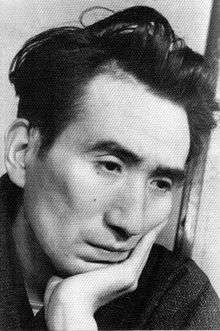 Dazai Osamu | |
| Born |
Shūji Tsushima June 19, 1909 Kanagi, Aomori, Japan |
| Died |
June 13, 1948 (aged 38) Tokyo, Japan |
| Occupation | Writer |
| Genre | Novels, short stories |
| Literary movement | I novel, Buraiha |
Osamu Dazai (太宰 治 Dazai Osamu, June 19, 1909 – June 13, 1948) was a Japanese author who is considered one of the foremost fiction writers of 20th-century Japan. A number of his most popular works, such as The Setting Sun (Shayō) and No Longer Human (Ningen Shikkaku), are considered modern-day classics in Japan. With a semi-autobiographical style and transparency into his personal life, Dazai’s stories have intrigued the minds of many readers. His books also bring about awareness to a number of important topics such as human nature, mental illness, social relationships, and postwar Japan.
One such literary work, No Longer Human, has received quite a few adaptations: a film directed by Genjiro Arato, the first four episodes of the anime series Aoi Bungaku, and a manga serialized in Shinchosha's Comic Bunch magazine. While Dazai continues to be widely celebrated in Japan, he remains relatively unknown in the United States with only a handful of his novels available in English.
Life and career
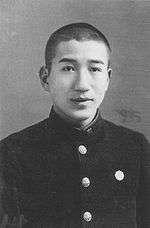
Dazai was born Shūji Tsushima (津島修治 Tsushima Shūji), the eighth surviving child of a wealthy landowner in Kanagi, a remote corner of Japan at the northern tip of Tōhoku in Aomori Prefecture. He spent these early years in the Tsushima mansion with some thirty people. Despite coming from very humble beginnings, the Tsushima family quickly rose in power and after some time, became highly respected across the region. Dazai's father, Gen'emon Tsushima, became politically involved and was offered membership into the House of Peers. This made Dazai's father absent during much of his early childhood, and with his mother, Tane, chronically ill after having given birth to 11 children, Tsushima was brought up mostly by the family's servants.
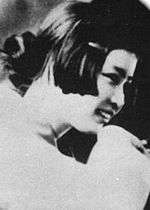
In 1923, Tsushima attended Aomori High School and entered Hirosaki University's literature department in 1927. He developed an interest in Edo culture and began studying gidayū. Around 1928, Tsushima edited a series of student publications and contributed some of his own works, such as "Aware ga" (Poor Mosquito). He even published a magazine called Saibō bungei (Cell Literature) with his friends, and subsequently became a staff member of the college's newspaper team. His success in writing was brought to a halt, when his idol, the writer Ryūnosuke Akutagawa committed suicide in 1927. Tsushima started to neglect his studies, and spent the majority of his allowance on clothes, alcohol and prostitutes and dabbled with Marxism, which at the time was heavily suppressed by the government. He frequently expressed guilt in his earliest writings about having been born into an incorrect social class. On the night of December 10, 1929, Tsushima committed his first suicide attempt, but survived and was able to graduate the following year.
In 1930, Tsushima enrolled in the French Literature Department of Tokyo Imperial University and promptly stopped studying again. In October, he ran away with a geisha named Hatsuyo Oyama (小山初代 Oyama Hatsuyo) and was formally expelled from his family. Nine days after the expulsion, Tsushima attempted suicide by drowning off a beach in Kamakura with another woman, 19-year-old bar hostess Shimeko Tanabe (田部シメ子 Tanabe Shimeko). Shimeko died, but Tsushima lived, having been rescued by a fishing boat. He was charged as an accomplice in her death. Shocked by the events, Tsushima's family intervened to drop a police investigation, his allowance was reinstated and he was released of any charges. In December, Tsushima recovered at Ikarigaseki and married Hatsuyo there.
Soon after, Tsushima was arrested for his involvement with the banned Japanese Communist Party and, upon learning this, his elder brother Bunji promptly cut off his allowance again. Tsushima went into hiding, but Bunji managed to get word to him that charges would be dropped and the allowance reinstated yet again if he solemnly promised to graduate and swear off any involvement with the party. Tsushima took up the offer.
Early literary career
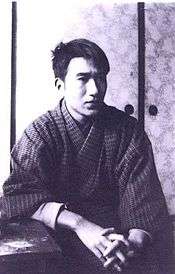
Tsushima kept his promise and settled down a bit. He managed to obtain the assistance of established writer Masuji Ibuse, whose connections enabled him to get his works published, and who helped establish his reputation.
The next few years were productive for Tsushima. He wrote at a feverish pace and used the pen name "Osamu Dazai" for the first time in a short story called Ressha (列車 Train 1933): his first experiment with the first-person autobiographical style that later became his trademark. But in 1935, it started to become clear to Dazai that he would not graduate, and he failed to obtain a job at a Tokyo newspaper as well. He finished The Final Years, which was intended to be his farewell to the world, and tried to hang himself March 19, 1935, failing yet again.
Less than three weeks after his third suicide attempt, Dazai developed acute appendicitis and was hospitalized, during which time he became addicted to Pabinal, a morphine-based painkiller. After fighting the addiction for a year, in October 1936 he was taken to a mental institution, locked in a room and forced to quit cold turkey. The treatment lasted over a month, during which time Dazai's wife Hatsuyo committed adultery with his best friend Zenshirō Kodate. This eventually came to light and Dazai attempted to commit double suicide with his wife. They both took sleeping pills, but neither one died, so he divorced her. He quickly remarried, this time to a middle school teacher named Michiko Ishihara (石原美知子 Ishihara Michiko). Their first daughter, Sonoko (園子), was born in June 1941.
In the 1930s and 1940s, Dazai wrote a number of subtle novels and short stories that are autobiographical in nature. His first story, Gyofukuki (魚服記 1933), is a grim fantasy involving suicide. Other stories written during this period include Dōke no hana (道化の花 The Flowers of Buffoonery, 1935), Gyakkō (逆行 Against the Current, 1935), Kyōgen no kami (狂言の神 The God of Farce, 1936), an epistolary novel Kyokō no Haru (虚構の春 False Spring, 1936) and those published in his 1936 collection Bannen (Declining Years), which describe his sense of personal isolation and his debauchery.
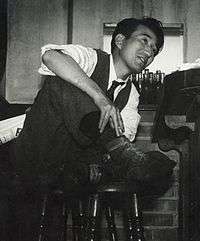
Wartime years
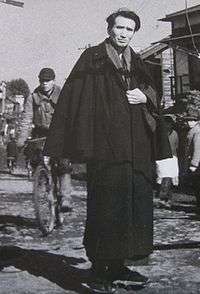
Japan entered the Pacific War in December, but Dazai was excused from the draft because of his chronic chest problems (he was diagnosed with tuberculosis). The censors became more reluctant to accept Dazai's offbeat work, but he managed to publish quite a bit anyway, remaining one of the very few authors who managed to get this kind of material accepted in those years. A number of the stories, which Dazai published during World War II were retellings of stories by Ihara Saikaku (1642–1693). His wartime works included Udaijin Sanetomo (Minister of the Right Sanetomo, 1943), Tsugaru (1944), Pandora no hako (Pandora's Box, 1945–46), and the delightful Otogizōshi (Fairy Tales, 1945) in which he retold a number of old Japanese fairy tales with vividness and wit.
His house was burned down twice in the American air raids against Tokyo, but Dazai's family escaped unscathed, with a son, Masaki (正樹), born in 1944. His third child, daughter Satoko (里子), later became a famous writer under the pseudonym Yūko Tsushima (津島佑子), was born in May 1947.
Postwar career
In the immediate post-war period, Dazai reached the height of his popularity.
He depicted a dissolute life in postwar Tokyo in Viyon no Tsuma (Villon's Wife, 1947). The narrator is the wife of a poet who abandoned her. She takes a job from a tavern keeper her husband had stolen money from earlier on. Her determination to survive is tested by hardships, rape and her husband's self-delusion, yet her will to live on stays intact throughout it all.
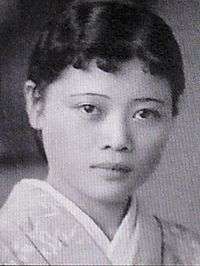
In July 1947 Dazai's best-known work, Shayo (The Setting Sun, translated 1956) depicting the decline of the Japanese nobility after World War II was published, propelling the already popular writer into a celebrity. This work was based on the diary of Shizuko Ōta (太田静子). Ōta was one of the fans of Dazai's works and first met him in about 1941. She bore him a daughter Haruko (治子) in 1947.
Always a heavy drinker, he became an alcoholic; he had already fathered a child out of wedlock with a fan, and his health was also rapidly deteriorating. At this time Dazai met Tomie Yamazaki (山崎富栄), a beautician and war widow who had lost her husband after 10 days of having been married. Dazai effectively abandoned his wife and children and moved in with Tomie. He began writing his quasi-autobiography Ningen Shikkaku (人間失格, No Longer Human, 1948, translated. 1958) at the hot-spring resort Atami. He moved to Ōmiya with Tomie and stayed there until mid-May, finishing his novel.
Ningen Shikkaku deals with the character Ōba Yōzō (大庭葉蔵) hurtling headlong towards self-destruction, all the while despairing of the seeming impossibility of changing the course of his life.[1] The novel is told in a brutally honest manner, devoid of all sentimentality. The book is one of the classics of Japanese literature and has been translated into several foreign languages.
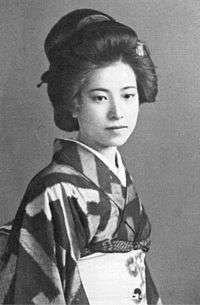
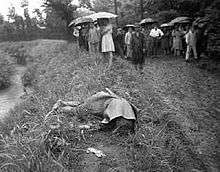
In the spring of 1948, he worked on a novelette scheduled to be serialized in the Asahi Shimbun newspaper, titled Guddo bai (Goodbye). It was never finished.
Death
On June 13, 1948 Dazai and Tomie drowned themselves in the rain-swollen Tamagawa Canal near his house. Their bodies were not discovered until June 19, which coincided with his 39th birthday. His grave is at the temple of Zenrin-ji, in Mitaka, Tokyo.
Major works
Major works by Dazai include:
| Year | Japanese Title | English Title | Comments |
|---|---|---|---|
| 1933 | 思い出 Omoide | Memories | in 'Bannen' |
| 1935 | 道化の華 Dōke no Hana | Flowers of Buffoonery | in 'Bannen' |
| 1936 | 虚構の春 Kyokō no Haru | False Spring | in 'Bannen' |
| 1936 | 晩年 Bannen | The Late Years | Collected short stories |
| 1937 | 二十世紀旗手 Nijusseiki Kishu | A standard-bearer of the twentieth century | |
| 1939 | 富嶽百景 Fugaku Hyakkei | One hundred views of Mount Fuji | |
| 女生徒 Joseito | Schoolgirl | ||
| 1940 | 女の決闘 Onna no Kettō | Women's Duel | |
| 駈込み訴へ Kakekomi Uttae | An urgent appeal | ||
| 走れメロス Hashire Merosu | Run, Melos! | ||
| 1941 | 新ハムレット Shin-Hamuretto | New Hamlet | |
| 1942 | 正義と微笑 Seigi to Bisho | Right and Smile | |
| 1943 | 右大臣実朝 Udaijin Sanetomo | Minister of the Right Sanetomo | |
| 1944 | 津軽 Tsugaru | Tsugaru | |
| 1945 | パンドラの匣 Pandora no Hako | Pandora's Box | |
| 新釈諸国噺 Shinshaku Shokoku Banashi | A new version of countries' tales | ||
| 惜別 Sekibetsu | A farewell with regret | ||
| お伽草紙 Otogizōshi | Fairy Tales | ||
| 1946 | 冬の花火 Fuyu no Hanabi | Winter's firework | Play |
| 1947 | ヴィヨンの妻 Viyon No Tsuma | Villon's Wife | |
| 斜陽 Shayō | The Setting Sun | ||
| 1948 | 如是我聞 Nyozegamon | I heard it in this way | Essay |
| 桜桃 Ōtō | A Cherry | ||
| 人間失格 Ningen Shikkaku | No Longer Human | ||
| グッド・バイ Guddo-bai | Good-Bye | Unfinished | |
See also
Selected bibliography of English translations
- The Setting Sun (斜陽 Shayō), translated by Donald Keene. Norfolk, Connecticut, James Laughlin, 1956. (Japanese publication: 1947).
- No Longer Human (人間失格 Ningen Shikkaku), translated by Donald Keene. Norfolk, Connecticut, New Directions Publishers, 1958.
- Dazai Osamu, Selected Stories and Sketches, translated by James O’Brien. Ithaca, New York, China-Japan Program, Cornell University, 1983?
- Return to Tsugaru: Travels of a Purple Tramp (津軽), translated by James Westerhoven. New York, Kodansha International Ltd., 1985.
- Run, Melos! and Other Stories. Trans. Ralph F. McCarthy. Tokyo: Kodansha International, 1988. Tokyo: Kodansha English Library, 1988.
- Crackling Mountain and other stories, translated by James O’Brien. Rutland, Vermont, Charles E. Tuttle Company, 1989.
- Blue Bamboo: Tales of Fantasy and Romance, translated by Ralph F. McCarthy. Tokyo and New York, Kodansha International, 1993.
- Schoolgirl (女生徒 Joseito), translated by Allison Markin Powell. New York: One Peace Books, 2011.
- Otogizōshi: The Fairy Tale Book of Dazai Osamu (お伽草紙 Otogizōshi), translated by Ralph F. McCarthy. Fukuoka, Kurodahan Press, 2011.
- Blue Bamboo: Tales by Dazai Osamu (竹青 Chikusei), translated by Ralph F. McCarthy. Fukuoka, Kurodahan Press, 2012.
Bibliography
- Lyons, Phyllis. The Saga of Dazai Osamu: A Critical Study With Translations. Stanford University Press (1985). ISBN 0-8047-1197-6
- O'Brien, James A. Dazai Osamu. New York: Twayne Publishers, 1975.
- O'Brien, James A., ed. Akutagawa and Dazai: Instances of Literary Adaptation. Cornell University Press, 1983.
- Ueda, Makoto. Modern Japanese Writers and the Nature of Literature. Stanford University Press, 1976.
- Wolf, Allan Stephen. Suicidal Narrative in Modern Japan: The Case of Dazai Osamu. Princeton University Press (1990). ISBN 0-691-06774-0
- "Nation and Region in the Work of Dazai Osamu," in Roy Starrs Japanese Cultural Nationalism: At Home and in the Asia Pacific. London: Global Oriental. 2004. ISBN 1-901903-11-7.
References
- ↑ "The Disqualified Life of Osamu Dazai" by Eugene Thacker, Japan Times, 26 Mar. 2016.
External links
| Wikimedia Commons has media related to Osamu Dazai. |
- e-texts of Osamu's works at Aozora bunko
- Osamu's short story "Waiting" at the Wayback Machine (archived December 11, 2007)
- Osamu Dazai's grave
- Synopsis of Japanese Short Stories (Otogi Zoshi) at JLPP (Japanese Literature Publishing Project) (English)
- Osamu Dazai at the Internet Speculative Fiction Database
- Works by or about Osamu Dazai at Internet Archive
- Works by Osamu Dazai at LibriVox (public domain audiobooks)
